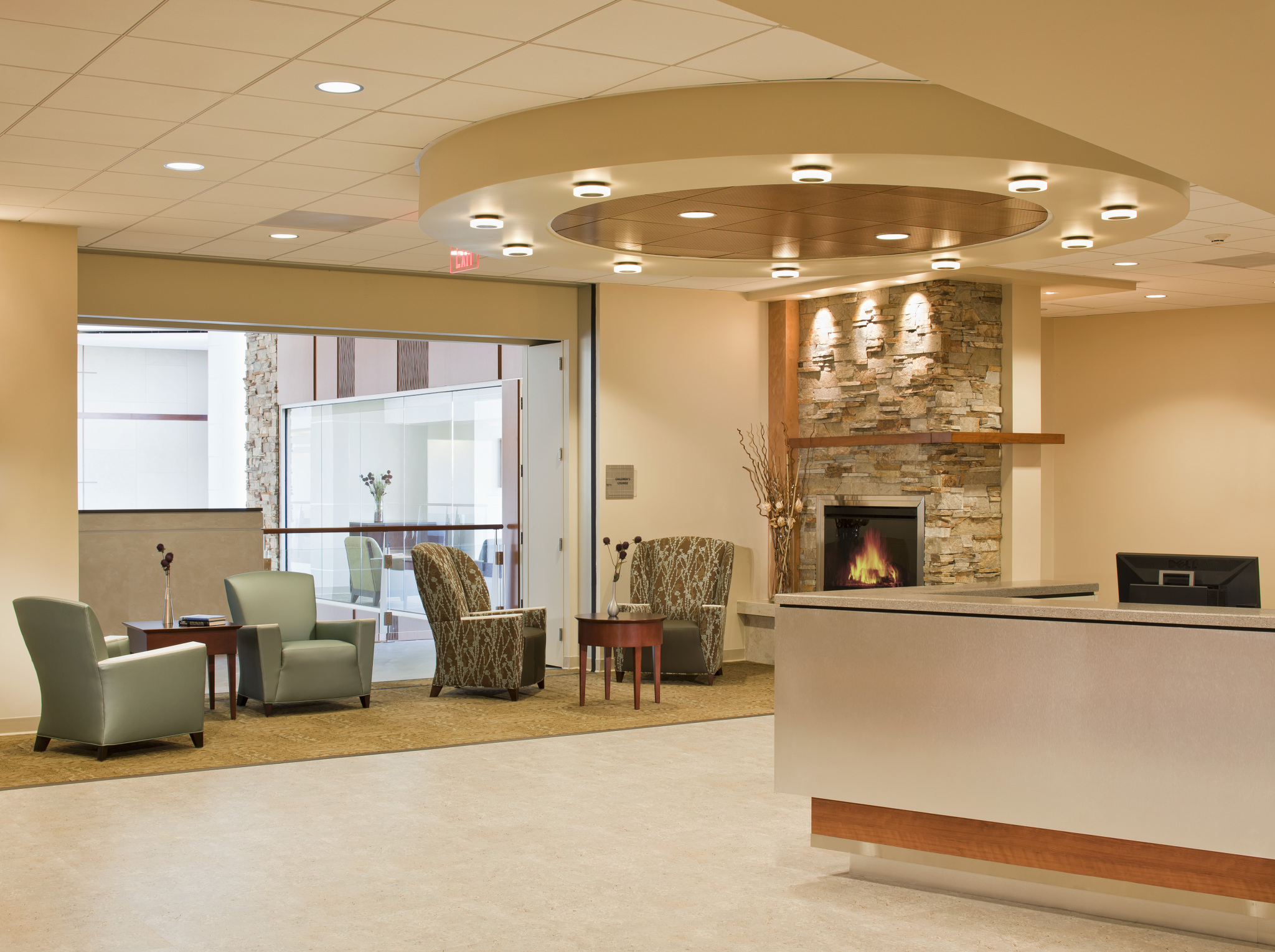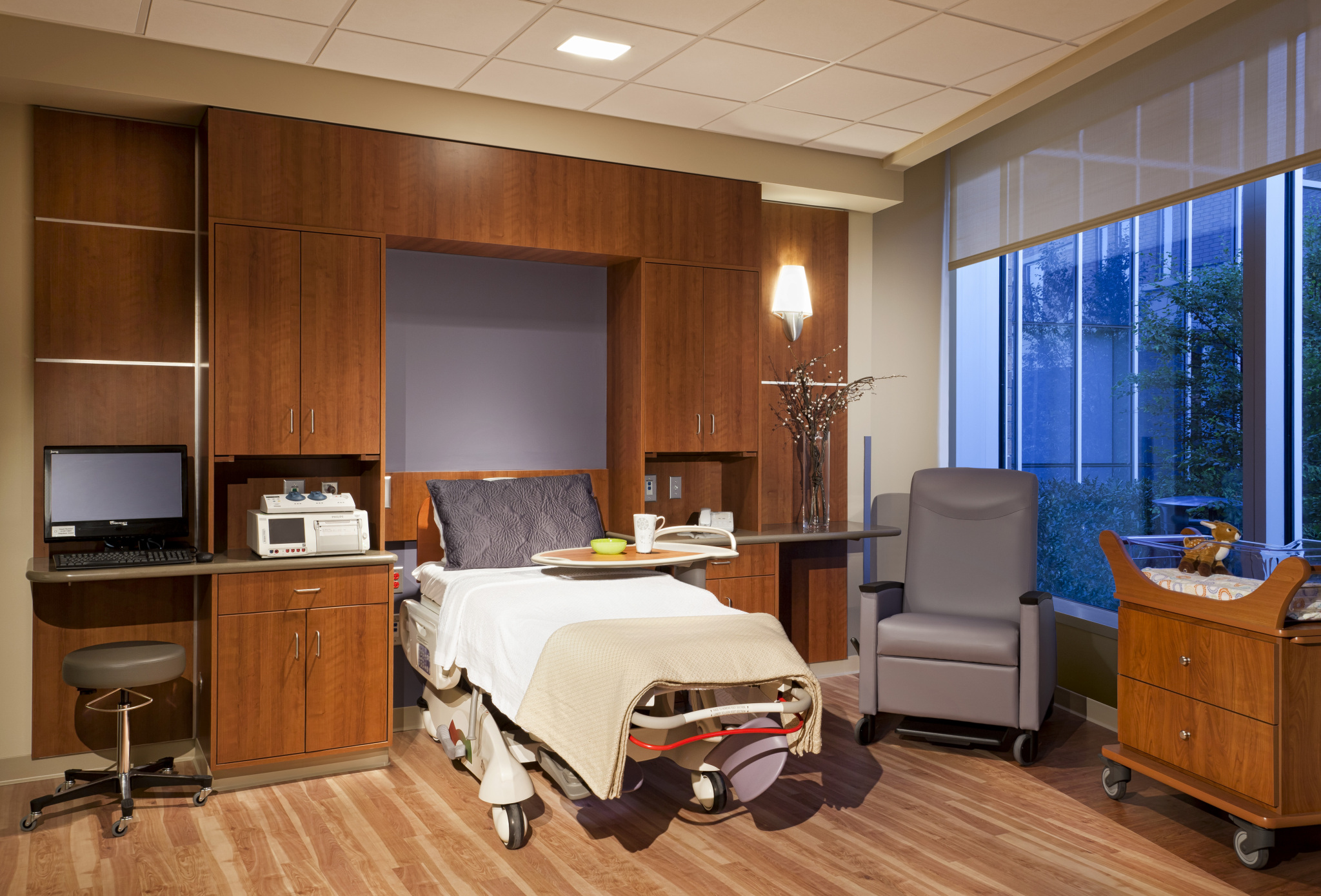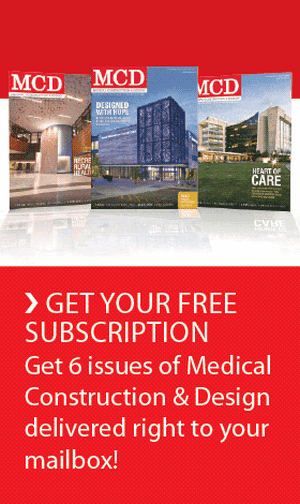Subscribe Now
Sustainable Interiors Help Create LEED-Gold Certified Hospital
 By Nicole Wood
By Nicole Wood
Capital Health Medical Center – Hopewell recently achieved LEED-Gold status from the U.S. Green Building Council. This six-story, 570,000-square-foot replacement hospital with an integrated, 330,000-square-foot medical office building was designed by Array Architects in collaboration with HKS Architects and Anchor Health Properties and is one of 28 other hospitals in the country to have received LEED Platinum or Gold status. Interiors were of particular concern to designers in achieving ultimate sustainability, while addressing patient comfort and reassurance. Ceilings, flooring, wall covering, millwork, lighting and indoor air quality played a large part in earning the Gold.
The design and construction, both inside and out, of a LEED-Gold hospital entails countless design and construction details. Starting with the goal of achieving basic LEED certification, as the design process progressed through its various stages, it became increasingly apparent to the design team that LEED-Gold certification was achievable.
Array worked diligently to vet sustainable and regional materials (MRc4.1 & 4.2, MRc5.1 & 5.2), as well as the impact during installation to the indoor air quality (EQc4.1, 4.2, 4.3 & 4.4) to achieve maximum point values. Key interiors highlights include:
Ceilings
Research for this area was fairly simple to obtain as manufacturers of ceilings have been leading the charge in sustainable practices. Designers looked not only for highly recycled content, but also for a regional manufacturer that could handle the extensive interiors needs of a hospital environment with regard to acoustics, cleanability and aesthetics.
Floors
Flooring was more challenge to tackle. Indoor air quality played the biggest role in these interiors selections. Research led to products that were PVC-free due to the association between PVC and the release of highly toxic dioxins and reproductive toxicants, as well as being CRI Green Label Plus certified. PVC-free floorings selected include rubber and PVC-free vinyl, which are also some of the lowest maintenance options available needing no waxing or buffing. This reduced the chemicals needed to clean and maintain the floors and minimized the human exposure to unhealthy toxins. These flooring selections also have great acoustic values, ensuring a quiet patient environment.
Carpet backing and adhesives were selected to be CRI Green Label Plus, assured by a third-party testing process to have some of the lowest emissions in the industry, achieving EQ credits 4.1 & 4.3.
Walls
In addition to using locally sourced gypsum wallboard, all the paint and primer used were low-VOC water-based paints (not to exceed 10 g/l). Compared to traditional paints, this made the interior environment during the painting process a much easier place in which to work. Wall protection in the form of sheet goods, handrails and bumper guards were all made with PVC & PBT-free materials and were Cradle-to-Cradle Certified.
Millwork
Decreasing the VOCs in the building interiors even further was achieved by using substrates and adhesives such as particleboard that had recycled content. High-recycled content, low-VOC construction materials including gypsum wallboard, ceiling tile, carpet, resilient floor tile and recycled MDF substrates for millwork were used to offset the amount of new materials being used onsite. This resulted in more than 20 percent pre and post-consumer recycled products. All interior finish materials were selected for highly-recycled content or availability from a regional source. More than 25 percent of the materials were sourced from within 500 miles of the site. This included millwork, wood and doors, hardware, glass, decorative resin, ceilings, flooring and paint.
Lighting and Indoor Environmental Quality
In general, the building is controlled by an overall timeclock system. This timeclock system covers all general public interior spaces such as the lobby, atrium, dining and mall areas, as well as all public corridors. Since this is a 24-hour facility, there will always be a need for some lighting in the corridors. But since there are also concerns about patient care and quality of patient sleep, all corridors and general public space lighting has been divided into a minimum of three different control zones, with the general public spaces having many more levels of control. This strategy allows the hospital to decrease the amount of general lighting in the corridors and public spaces at night. Because these are general access spaces, there aren’t typical local controls, but a master control station is located at the main desk of the medicalcenter so that occupants can easily request interior lighting changes to these general spaces if required.
The lighting in the patient corridors is also controlled locally at the nurse stations so that the staff can adjust the corridor lighting in their zones to suit the requirements of each unit.
 All larger multi-occupant interior spaces such as large storage and work rooms, large conference rooms, waiting rooms, the servery and the kitchen also have overall timeclock controls with local override switches in addition to local on/off switching for occupant control. These interiors are large and have zoned lighting controls so that occupants can turn on as much or as little light as needed to perform tasks. The controls are located at each room entrance for convenience. For the waiting room areas, the lights are typically controlled at the reception or registration desk and local table lamps are provided throughout to allow for localized light-level control.
All larger multi-occupant interior spaces such as large storage and work rooms, large conference rooms, waiting rooms, the servery and the kitchen also have overall timeclock controls with local override switches in addition to local on/off switching for occupant control. These interiors are large and have zoned lighting controls so that occupants can turn on as much or as little light as needed to perform tasks. The controls are located at each room entrance for convenience. For the waiting room areas, the lights are typically controlled at the reception or registration desk and local table lamps are provided throughout to allow for localized light-level control.
All smaller interior spaces such as offices, small conference rooms, medication rooms, employee break rooms, on-call rooms and small toilet rooms have occupancy sensor controls. These rooms can be lit regardless of the time of day. For rooms that typically have a regular occupant – such as offices – there is also local task lighting to allow those occupants to increase the light level if required. For multi-occupant interior spaces such as conference rooms where the tasks vary by user group, the lighting is controlled so that there is a minimum of two lighting zones, enabling occupants to vary the light level as required.
All patient room interior lighting is controlled by local switches. The switches are located at the door to the room, as well as at the patient bed headwall so that occupants can control the lighting in their room. All patient rooms are provided with a minimum of three lighting systems to suit patients and clinicians’ needs.
The overall vision for the Capital Health Medical Center was to take the current hospitality trend in healthcare and push it to new heights. The project motto, “I can’t believe it’s a hospital,” was derived from an intense series of visioning meetings at  the beginning of the project. From programming through the interior design process and into construction, this motto has been the ongoing mantra of the entire design team.
the beginning of the project. From programming through the interior design process and into construction, this motto has been the ongoing mantra of the entire design team.
The hospital, featuring a 223-bed patient tower, is the first phase of a projected three-phase, 500-bed master plan. The facility blends the history of Capital Health, the comfort of a hospitality setting and the complex, high-tech aspect of modern medical care. This new medical center has been recognized as a leader in the delivery of quality healthcare, while maintaining the comfort and reassurance of the emotional and spiritual balance of its patients, visitors and staff. With the recent LEED-Gold certification, it is recognized as a leader in sustainable design for interiors as well.
Click here for the YouTube video, “Designing Capital Health Hopewell”
Click here for more information on Capital Health’s LEED Gold Certification on USGBC’s website
Nicole Wood is an interior designer with Array Architects. She can be reached at nwood@array-architects.com.
Tags:
Posted January 15, 2013
More Articles:
- Developments in BIM Virtual Symposium
Dec 3, 2024 – Dec 3, 2024 - Healthcare Environments 2024
Dec 8, 2024 – Dec 10, 2024 - IHI Forum
Dec 8, 2024 – Dec 11, 2024 - Construction SuperConference
Dec 9, 2024 – Dec 11, 2024 - 2024 New Orleans Cluster
Dec 9, 2024 – Dec 11, 2024 - EBD Journal Club: Blue Space: Extracting the Sensory Characteristics of Waterscapes as a Potential Tool for Anxiety Mitigation
Dec 17, 2024 – Dec 17, 2024















